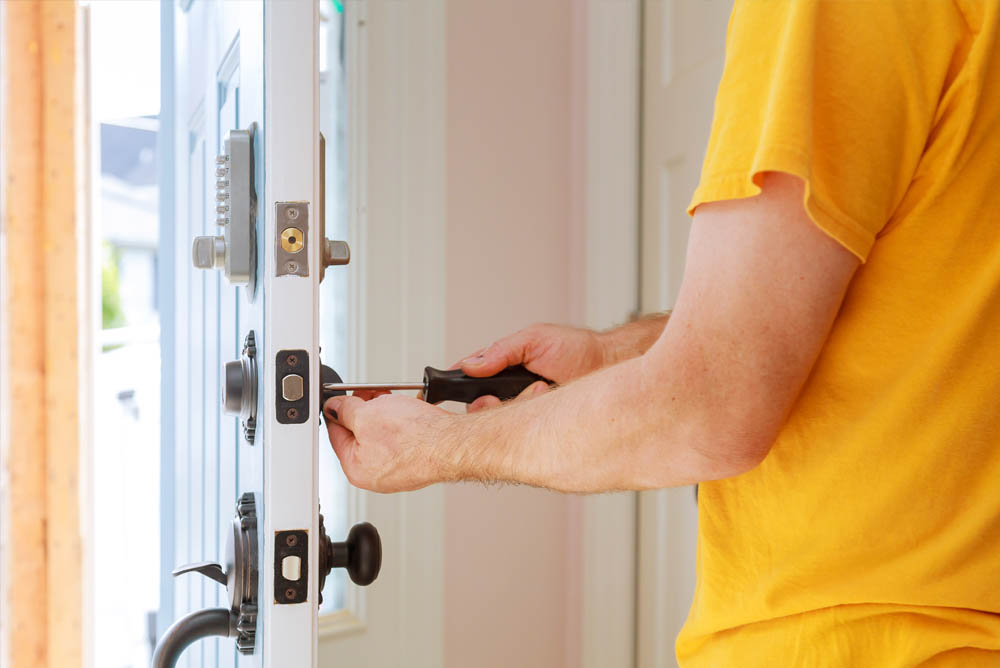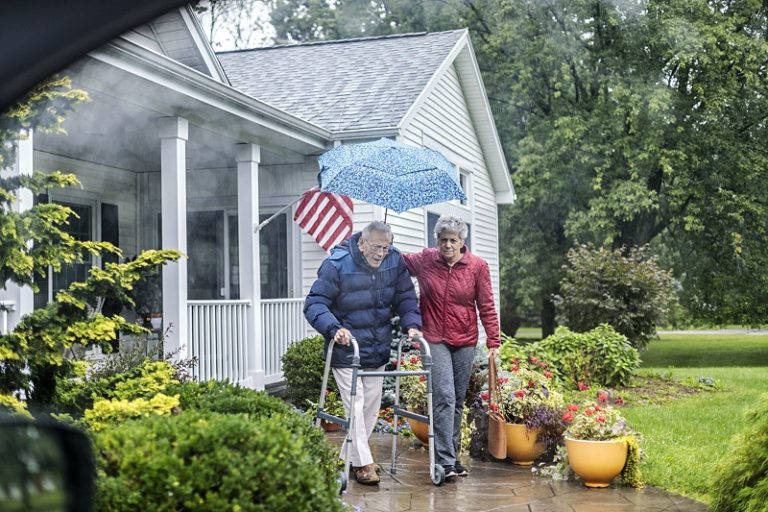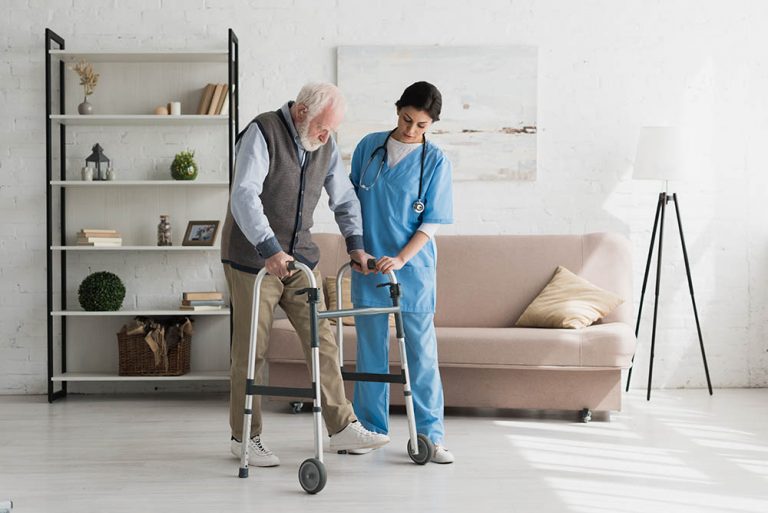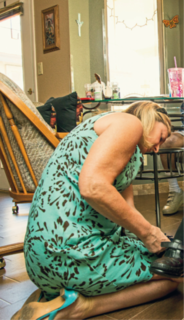Evaluating a senior’s ability to safely age in place is a complex process. The vast majority– a whopping 75 percent of older adults want to stay in their homes rather than move to assisted living or other adult care communities, however each senior has their own needs and concerns regarding functioning independently at home.
One approach to creating a safer environment for seniors is applying the methods of universal design. Universal design focuses on designing, constructing or adapting buildings, products and environments to make them accessible to all people, regardless of age or ability.
Nanette Overly, vice president of sales and marketing for Epcon Communities based in Dublin, Ohio, points to the importance of constructing a home that supports your lifestyle now and in the future. Implementing universal design principles is one way of ensuring a senior’s current home is suitable for aging in place. Common examples of universal design include wide hallways, open floor plans, flat panel light switches at correct heights, and other elements that pay extra attention to accessibility and ease of use. Overly notes that almost every room and area of an existing home can be adapted following these principles to help reduce falls, injuries and accidents.
In order to devise a customized solution for your loved one’s residence, carefully assess each room and use the following tips to make modifications and improvements that allow a senior to live at home as long as safely possible.
Checklist: Home Modifications to Keep a Senior Safe at Home
General Household Safety Tips
- Move furniture to clear walking paths.
- Make light switches accessible by placing them no higher than 48 inches and replacing toggle switches with rocker style
- Improve overall lighting in the home. Light dark pathways or countertop areas with easy to install rope lighting. Add task lights and night lights wherever needed.
- Replace doorknobs with levered handles or pulls or add doorknob grips.
- Mark changes in floor levels with tape or paint in a high-contrast color.
- Remove loose carpeting and unnecessary throw rugs. Fasten down area rugs with double-sided rug tape.
- Remove all electric, cable and extension cords that run across or near walkways. If necessary, place electric cords behind furniture.
- Replace unsteady chairs with chairs that have sturdy arms to make transitioning from sit-to-stand easier.
- Lock thermostats to control temperature.
- Remove clutter by donating or disposing of items that are no longer of use.
- Make sure trash receptacles are easily accessible from inside the home and can be brought to the curb without obstruction.
- Repurpose a closet or other area on the main living level to make laundry machines accessible. Replace top-loading machines with front-loading appliances that are easier to use. If necessary, laundry can be outsourced to a per pound laundry service or added to the tasks completed by a home care aide.
- Ensure smoke alarms and carbon monoxide detectors are placed in all key areas. Test them and change batteries regularly.
Entryway Safety Tips for Seniors
- Clear a convenient path from the driveway to the entry.
- Ensure walkways are free from loose bricks and cracks.
- Remove or trim landscaping so that walking paths are wide enough for someone using a wheelchair or walker.
- If there are entry steps, install handrails on both sides of any stairs and ensure stair treads are non-slip and deep enough for the whole foot.
- As mobility challenges increase, evaluate if there is room for the installation of a ramp.
- Evaluate the safety of the front door. Are locks sturdy and easy to operate? Is there a window panel or peephole in the proper location?
- Step-less entries make it easier and safer to gain access, whether the person is in a wheelchair or using a walker or cane. Install threshold ramps wherever possible.
- Add swing-clear hinges to doors or hire a handyman to widen existing doorways.
Kitchen Safety Tips for Seniors
- Increase wattage of lightbulbs in task areas for better visibility.
- Replace cabinet knobs with easy to operate levers or pulls.
- Move frequently used items from high shelves and cabinets to countertops or under-the-counter cabinets.
- Consider the functionality of older appliances. Ideally, oven controls should be placed at the front of the range rather than toward the rear to prevent reaching over the stove. Knobs should be clearly labeled and easy to use. A thin layer of paraffin wax or petroleum jelly can be rubbed around the gasket of a refrigerator door that is difficult to open.
- Replace small appliances, such as coffee makers and toaster ovens, with models that have an automatic shut-off feature.
- Use colorful dishes, utensils and cookware that contrast with the color of countertops, tabletops and storage areas to help an elder with poor eyesight navigate the kitchen.
- Thermometers and timers with flashing lights or voice capabilities can be used to alert someone that dinner’s ready.
- Push the kitchen table against the wall to open up floor space.
- Use a “Lazy Susan” to increase access to out-of-reach items on the dining table or on shelves.
Bedroom Safety Tips for Seniors
- Clear the walking path of any furniture or rugs that may cause tripping.
- Adjust the bed height for easy transfers. If a senior cannot comfortably sit on the edge of the bed with their knees bent and their feet on the floor, adjust the height with risers if it’s too low, or by removing or using a low-profile box spring if it’s too high.
- Add bedrails or pull-up devices under the mattress to assist with sitting up when in
- Add a working flashlight to the nightstand.
- Consider adding a bedside commode to avoid nighttime trips to the bathroom.
Bathroom Safety Tips for Seniors
- Install grab bars for additional support while toileting and while getting into and out of the shower/bath.
- Abundant lighting for the overall space as well as tasks is essential. Special waterproof incandescent lights should be placed in the ceiling of a shower and over a tub for extra visibility.
- Set the hot water heater to 120 degrees Fahrenheit or lower, clearly label hot and cold faucets and consider installing anti-scald devices on faucets to prevent burns.
- Showers should have a step-free entry. There are step-in tub models available that feature a door for easy entrance and exit. The shower should be fitted with a seat, a hand-held shower sprayer, and a niche to hold soap and shampoo at a level that can be reached easily.
- Floors should be slip-resistant wood, vinyl, or tile with a lot of grout for traction. Add non-skid decals to any slippery areas in the bathroom.
- All cabinets and drawers should be fitted with levers or pulls rather than knobs.
- A comfort-height toilet model should be selected that is 2 inches higher than normal and easier to transfer onto from a wheelchair. A toilet seat riser can be added to an existing toilet.
- Lighting modifications along a hallway can provide a clear path to a bathroom in the dead of night when eyesight is failing.
- Curbless showers with a bench allow someone to roll a wheelchair in and bathe.
Costs of Aging in Place Modifications
Will Johnson, a builder based in Pittsboro, N.C., estimates that incorporating universal design in a new build can range from $500 to $5,000. Certain items, such as a zero-step entry from a garage into a house if there’s a steep grade, a curbless shower and cabinetry modifications, often increase costs.
When it came to his dad’s home, Johnson found that a bit of creativity helps when considering aging in place solutions. He became interested in the universal design field after his father had a stroke. “He was living in an older home and couldn’t get to the upstairs master bedroom or use the powder room since the doorway was only two feet wide,” he recalls. “The house was unlivable for him, but it was too expensive to modify.”
Johnson’s solution was to build a new one-level house for his father. “It’s totally accessible but you’d never know. We painted rugs on the hardwood floor since we couldn’t have rugs with the wheelchair. It’s a joy to have wide hallways and no steps, not just for him, but for all of us to be able to maneuver,” he says.
By incorporating universal design features from the beginning rather than as a retrofit, costs go down remarkably—about one-third less, explains Rebecca Stahr, CEO of LifeSpring Environs, Inc., an Atlanta-based aging-in-place consultancy.
However, if you’re looking for help addressing some of the needs in your parent’s longtime residence, the national average cost of a home handyman is $77 an hour according to HomeAdvisor. Hiring a handyman adds a degree of professionalism to many home modifications. Local Area Agency on Aging programs often provide referrals to licensed individuals who are experienced in making modifications for elders.
Many home modifications are fairly inexpensive and can be accomplished as do-it-yourself projects with purchases from reputable retailers. In fact, getting started by removing items from the home to reduce fall risks and improve mobility in the space can be accomplished without any cost at all. Improving lighting with higher wattage lightbulbs, replacing knobs with handles, and regulating water temperatures are all examples of simple and inexpensive fixes that can have a big impact on an elder’s everyday life.
Monitor Changes in a Senior’s Abilities
Care needs change over time. AgingCare created an assessment checklist to evaluate a senior’s ability to function independently in their environment. Use this checklist as a guide for home modifications that can help improve an elder’s functional independence. As your aging loved one’s needs and abilities change, use this tool to develop a targeted care plan of appropriate services and support.
(https://www.agingcare.com/articles/making-home-safer-for-seniors-a-room-by-room-assessment-121363.htm)






